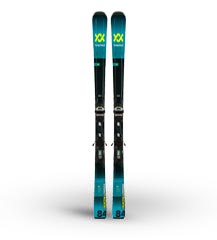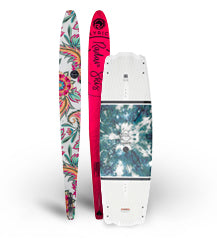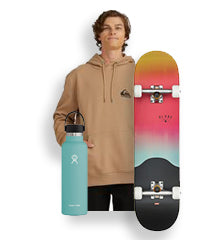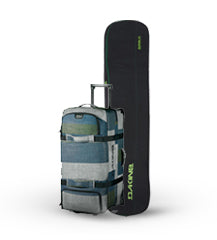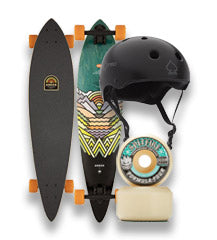Tips For Buying Snow Goggles
July 21, 2020 9 min read
Shop Goggles Now - Fast & Free Shipping Available 🙌
Do I need to wear goggles?
It doesn't matter if its puking snow or a bluebird day, goggles are always a must. Asides from the obvious that snow goggles help you to see in a variety of conditions but almost more importantly they protect your eyes from physical damage from tree branches, snow or dirt, but also harmful light rays. Snow can act as a huge mirror and reflect the light back up at you and just like getting sunburn in the summer; you can get's now burn' in the winter which can cause severe damage over time and even snow blindness.
How do I find the right fit?
Finding the right fitting goggles is like finding the right fitting boots, you will know when you have the right ones. It's a good idea to buy your helmet and goggles at the same time, this way you know they fit together perfectly. If you already have a helmet, no worries just take it to the shop with you to try on with your new goggles. Getting the right fit to your helmet is essential, so the ventilation system in the goggles works with the ventilation system in the helmet. The perfect fit at the top of your goggles is no gap at all with all the vents in the top of your goggles lining up with the vents in the helmet if you have a gap between the top of your goggle and the brim of your helmet you're just asking for a cold forehead, not great! You also want to make sure your nose isn't being squashed or even covered by your goggles, this isn't comfortable, or a good look so make sure you get the right fit.
Small Fit
A small fit goggle is usually for youths or just people with a little head, if your helmet is a size small, you will probably need a smaller framed goggle to match. All goggle companies will make a small fit goggle, and some companies have specific smaller framed goggles like SPY or ANON. Others have a code or second name after the name of the goggle, For example, Oakley use Youth or XS, and Smith uses S.
Medium Fit
A regular fit goggle will fit pretty much everyone in a size medium or large helmet. Regular fit goggles are the most common and are the easiest to fit with helmets. You have a large choice of spherical or cylindrical lenses, and it will be easy to find replacement/spare lenses. An example of a medium-sized goggle would be anything XM from Oakley or the Axis from Giro.
Large/Oversized Fit
Large and oversized fits are the poster child of the ski and snowboard industry; they look great, have the best ventilation, and give you the most peripheral vision. However, they must fit well, or those benefits are null and void! An example of oversized goggles would be the Airbrake XL from Oakley or the PXV from Dragon.
What keeps your goggles from fogging?
All goggles will have some way of keeping their lenses from fogging; there are two widely used technologies: An anti-fog coating is sprayed on the inside of the lens in the factory. This coating was initially developed by NASA during project Gemini and works like a non-stick frying pan, water or water droplets can't stick to it, meaning no fog. However, just because water can't stick to something doesn't stop fogging. That's where our other technology comes in, passive ventilation. Like when you're driving your car, and the window keeps fogging up, what do you do? You blast it with air. The same thing needs to happen for your goggles, fresh air comes in at the bottom of the goggles, collects the hot air and water vapour and pushes it out the top and sides of the goggles. This is why goggles that sit far off your face are less likely to fog, as there is a lot more air within them.
Cylindrical vs Spherical Lenses - What's the difference?
There are two main types of lenses when it comes to ski goggles: Cylindrical and Spherical. While it is pretty much a fashion choice, as both will do a fantastic job at protecting your eyes and increasing your ability to see where you're going, there is some advantage and disadvantages to each lens style.
Cylindrical
A Cylindrical lens only has one axis of curvature and appears 'flat'. Traditionally all goggles were cylindrical where the lens is made flat and then bent to fit the goggle, while this an inexpensive way of making a lens it does cause a slight distortion to the user's vision and is often found in goggles under $150. Technology has progressed significantly since then allowing for better quality injection moulded lenses that don't distort your vision in much the same fashion a spherical lens creating a retro-looking lens. This is often found in cylindrical goggles over $200.
Spherical & Toric
A Spherical lens has two axis of curvature and is shaped to mimic the shape of your eyeball. Toric Lenses also have two axis of curvature but tighter curve than your eyeball, Both providing broader peripheral vision. The lens is rigid and often sits further away from your face offering more airflow and therefore, less fogging. All this comes at a price though; spherical goggles are usually more expensive starting around the $180 and going upwards of the $400 mark.
What about the goggle straps & foam?
The strap is the part of the goggle that keeps the lens and frame attached to your face so even though it seems like a minor detail without it, your goggles would be nearly useless. Every company does the strap a little different; some have thicker straps, some use clips; some use snapback fixings like a cap at the back. All goggle straps will be adjustable and should be comfortable to wear either with or without a helmet.
The padding is the soft foam that sits between the frame of the goggle and your face. This is also important as without it your goggles wouldn't protect you from wind, snow and chill. It also helps make a microclimate inside your goggles, helping them stay fog-free. Different thickness of foam/padding is used in different parts of the goggle to achieve the best fit possible. It's a small part, but it is going to be touching your face all day, so it needs to be comfortable.
Which colour lens tint is the right one?
Once you have decided between what shape your lens should be it's down to what tint or colour is best for you. The way to pick a lens colour is not by matching it to your outfit, sorry fashion gurus. The different colours of lenses are designed to help you in varying light conditions; this is why some goggles come with two lenses, one for bright light conditions and one for low light conditions. As well as the colour, you need to pay attention to the visible light transmission (VLT) this number reflects how much light is let through the lens; 0% VLT is no light at all and 100% VLT is all the light.
Sunny Conditions or High light
If you make most of your snow trips in the spring or you’re only a fair-weather skier, you will need a dark or low VLT lens, because you are more likely to get a bright or bluebird days and will need more protection from the bright light. Grab yourself a lens with a VLT lower than 15%, and your vision will be perfect. These are often your mirrored finish or reflective reds, greens and blue lenses and hide your eyes.
All conditions
If you make a lot of trips in moderate or mixed conditions and just want one lens to cover most conditions, a lens with a VLT of 10%-30% would be your best option. This lens will cover you during bright, but not full sun days, all the way down to overcast and days with a little bit of snow. You often find these tints in single-lens goggles and are often semi mirrored in reds, greens, and blue lenses that mostly hide your eyes.[
Foggy Conditions or Low light
If you're planning a trip in mid-winter, or when you're expecting massive amounts of snow and want to be out in it until it's getting dark, then a low light lens is what you will need. Low light lenses are usually not mirrored so they can let in as much light as possible and will generally be yellows or rose based lenses. Aim for a VLT at a minimum of 30% and ideally closer to 40% or 50%, they may not be the best looking, but you will be grateful in a whiteout.
Do I need two lenses?
A lot of ski goggles will come with two lenses, and nearly all will have the capability to change the lens out. This is good for your vision and your wallet. It's a good idea to have two lenses for your goggles to make sure your never caught out in the car park with your low light lens on a bluebird day. The wrong lens can result in being blinded by reflection off the snow or at the other end of the scale feel like you're wearing sunglasses indoors and not able to see where you're going. Buying a goggle that comes with two lenses rather than two goggles or trying to buy a spare lens later is the cheapest way to get the most from goggles.
Every company uses a different system to change the lens; they can be super easy, using magnets or difficult using clips that must be done in the right order. So, make sure when you buy a goggle you do a trial run changing the lenses at home.
Asian Fit/Global Fit
Global fit, or as it is more commonly known, Asian fit, is all about the nose section of the goggle, it is for people who have a shallower, less pronounced brow and just fills that gap around your nose with more foam. You don't have to be Asian to use an Asian fit goggle as the foam will just squash down anyway.
Over the Glasses Fit
Gone are the days of painful temples or losing one contact lens! Loads of goggle companies now make goggles that consider your glasses. This is usually called other the glasses (OTG) and simply put, part of the frame cutaway, so it doesn't push on the arms of your glasses combined with a large area inside the goggle for the lenses and frame of your glasses. Usually, these goggles will be a medium or large-sized frame to aid in fitting the glasses.
Tips & Tricks: Finding the Right Fit
The perfect fit, when you have it, you will know, however, here are some tips for finding the perfect fit.
- Make sure you always try your helmet on with your goggles before you go riding, if the goggle is too big then the helmet will push the goggle down your face and if your goggle is too small there will be a gap between the brim of the helmet and the top of the goggle.
- For the past ten years, goggles and helmets have been designed to fit together. If your helmet or goggle is older than ten years even if it isn't worn out and you are having trouble finding a good fit, consider replacing both!
- Bigger isn't always better, yes, the bigger the goggle the less likely it is to fog and the more peripheral vision you will get, however it needs to fit your face, so get the fit right and don't be driven by the size.
Tips & Tricks: Goggle Care
Once you have your killer new pair of goggles, you need to look after them, or you will find yourself back in the ski shop in no time. Here are some tips to make sure your goggles last as long as possible.
- DON'T TOUCH THE INSIDE OF THE LENS! This is the biggest killer or snow goggles, and it's tempting when your goggles fog or get snow in them to wipe the inside with a cloth or your finger. If you do this, you risk wiping off the anti-fog coating that helps your goggles stay clear. Goggles are the most delicate piece of snow kit, treat them as such.
- Let your goggles dry before putting them away. Your goggles like being wet and cold as much as you do, so after a long day on the slopes let them dry overnight at room temperature before putting them back in their pouch. This will prevent them from fogging up the next day.
- Never put your goggles on a heater, this includes drying rooms… The lenses are thin and can easily warp. Just don't!
- Keep your goggles on your face. Make sure your goggles are comfortable when you buy them because they need to stay on your face most of the day. Most damage to goggles happens when they are not on your face; scratched by the chairlift bar when it is pulled down or being wiped when they get fogged. The best place for your goggles is your face and let them do their thing. If your goggles fog you need to increase the airflow through them, when you're on the chair lift an easy way to do this is looking up, this pushes fresh air directly into the vents at the bottom of your goggles and clears them.
- Don't leave your goggles on your helmet at lunch; helmets are notorious for rolling or falling off tables and a sure-fire way to scratch your lens. Place your goggles back in their bag and then face down inside your helmet. You can put your gloves on top for good measure.
MOST POPULAR
RISING POST
Leave a comment
Comments will be approved before showing up.
Also in Blogs

How to Kneeboard for Beginners: Tips, Tricks, and Safety Advice
August 21, 2025 11 min read

The Ultimate Guide to Snowboarding at Rusutsu Resort, Hokkaido
July 15, 2025 13 min read

10 Wakeboarding Accessories Every Rider Needs in 2026
June 16, 2025 9 min read



